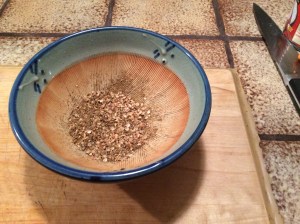Did you ever think there could be a “healthy” teriyaki sauce? Certainly one without MSG is making progress. But, what about one without granulated sugar? Impossible! Well, I’m going to give you an alternative…dates, yes dates. This sauce consists of medjool dates as the sweetener. What a brilliant idea, don’t you think? Simply soak them in warm water for a few minutes, then dump them with some garlic, ginger, soy sauce and rice vinegar into the jar of your blender. Puree all of them together with some of the soaking water from the dates until smooth. That’s all there is to it. It goes together very quickly.
I’m sorry to say I didn’t invent the sauce. I saw it in a post on the blog “A Pinch of Yum” for 30-Minute Sesame Mango Chicken. It was too good to pass up. If you are not familiar with that blog, it’s worth a visit as she posts some great recipes, many of them healthy and vegetarian.
This is a thicker sauce than my own “old” favorite using maple syrup. You’ll find that recipe here from an earlier post in February of this year.
I marinated some wild caught salmon steaks (the first of the season) in the sauce, then sautéed them quickly. They were still slightly pink in the middle, just the way we like them. Served with a quick stir fry of asparagus and snap peas with a spoonful of roast garlic lemon butter it was a quick and delicious mid-week dinner. You’ll find the recipe for the roast garlic and lemon butter here.
Teriyaki Sauce
- 15 Medjool dates, pitted and soaked in 1/2 cup of very warm water for 30 minutes
- 3/4 cup soy sauce, regular or low sodium
- 1/4 cup rice vinegar
- 3 cloves of garlic, peeled
- 1 tablespoon fresh ginger, minced or grated
- Optional – pinch of red pepper flakes
- Optional – 1/4 cup sesame oil
- Soak the pitted dates in the hot water
- Dump the dates and rest of the ingredients (including the soaking water) into your blender and blend until very smooth.
- Pour into a container until ready to use.
This will keep in the fridge for at least a week, we found it got “hotter” and spicier the longer it sat.
Grilled or Sautéed Salmon with Teriyaki Sauce
I sautéed the salmon steaks but they would be equally wonderful on the BBQ.
- Marinate salmon steaks or fillets in the sauce for at least 30 minutes or up to an hour in the fridge.
- Heat 3 tablespoons of peanut or other vegetable oil in your skillet on medium high heat.
- Add the salmon, skin side down.
- Saute on medium high heat for about approximately 10 minutes total for every inch of thickness. We like our salmon on the rare side and they weren’t quite so thick, so I started the steaks skin side down and turned them after 4 minutes.
Asparagus and Snap Peas with Roast Garlic and Lemon Butter
- 1 bunch of asparagus, ends snapped and cut into pieces about the length of the snap peas. I used a spiral diagonal cut, turning the stalk a half way round after each diagonal slice. That exposed more of the inner part of the stalk to the heat, cooking is a bit faster.
- About 3-4 cups of snap peas, stringed if necessary and cut in half lengthwise
- 4 scallions, cleaned and cut in half lengthwise, then into pieces the same size as the asparagus and peas.
- 2 tablespoons of roast garlic and lemon butter, (or 2 garlic cloves, finally minced, plus the zest and juice of one lemon, and 1 tablespoon of butter)
- 2 tablespoons of olive oil
- Salt and pepper to taste
- Heat the olive oil in a large skillet on medium low heat.
- If not using the roast garlic butter, add the minced garlic to the pan and saute until softened but not brown.
- Add the asparagus to the pan and turn up the heat to medium high. Saute for about 4 to 5 minutes until bright green and beginning to soften.
- Add the snap peas to the pan and saute for an additional 3 to 4 minutes until everything is bright spring green and slightly softened but still crisp.
- Finish with the roast garlic butter or add the lemon zest and juice plus the tablespoon of butter. Continue to heat until everything is coated with sauce.
- Add salt and pepper to taste and serve.
Salmon, asparagus, and fresh peas…this meal is the essence of spring. What are you serving to celebrate the season?
I’m taking this to share on Fiesta Friday #66 hosted by Angie. If you would like to see what is on the menu, come pay a visit to the party.


























